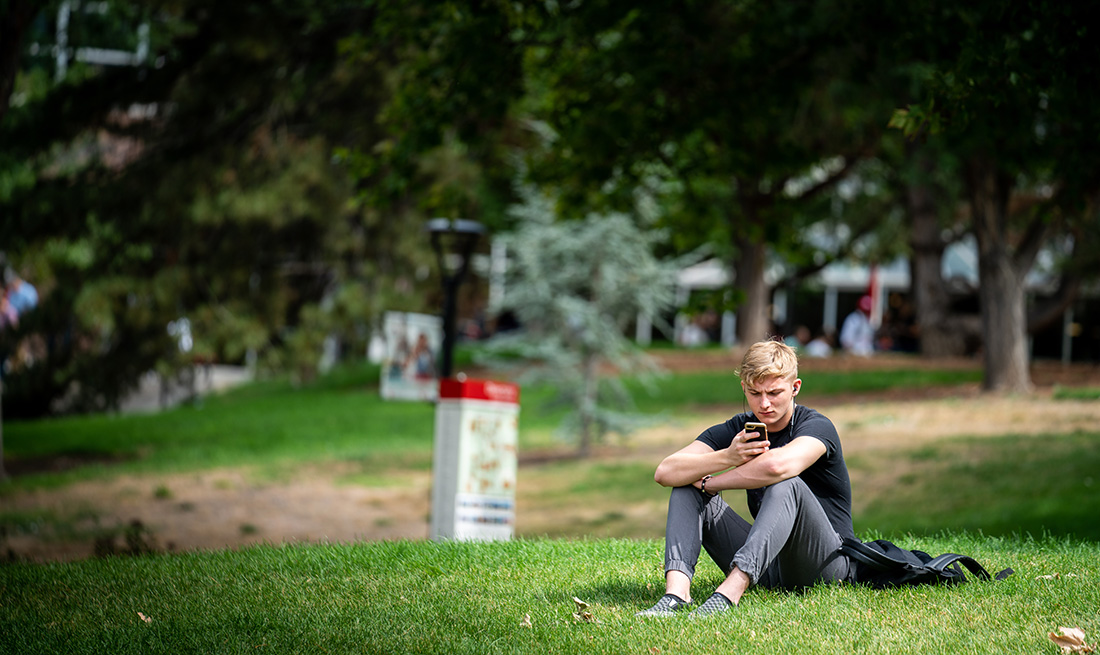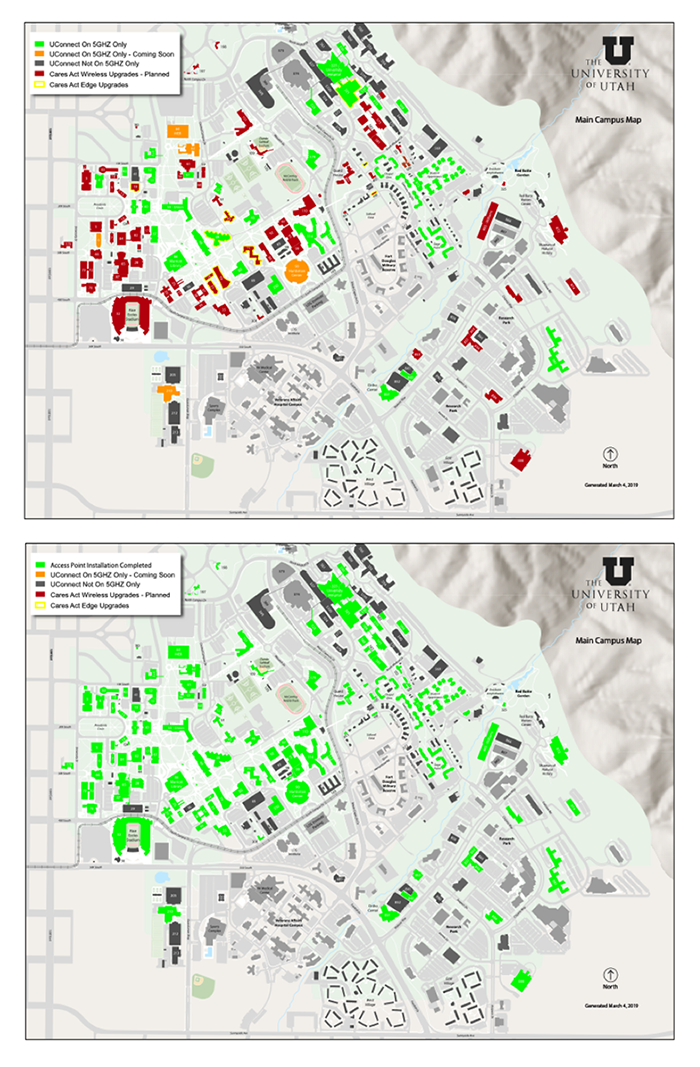You’re accessing archived content
This is archived content from the UIT website. Information may be outdated, and links may no longer function. Please contact stratcomm@it.utah.edu if you have any questions about archived content.
Network news
Outdoor Wi-Fi access on campus expanded

Image courtesy of the University of Utah.
Federal funds open new possibilities for outside connectivity
Adding Wi-Fi infrastructure in more outdoor areas was always part of the plan. Year in and out, UIT’s Network Services team strives to extend wireless coverage to more corners of campus. Before COVID-19, however, improving wireless access outdoors wasn’t as high a priority as indoor Wi-Fi.
“In a typical year, we’d maybe get two or three requests to mount new wireless access points, or APs, to the outside of a building. Indoors, we’d install 100, at the very most, 500,” Network Engineer Curtis Larsen said. “Last year, we had the money to install more than 3,000 APs indoors and 100 outdoors.”

Wi-Fi coverage at the U before and after CARES Act funding, courtesy of UIT Network Services (select to enlarge).
More than $11 million in funding from the Coronavirus Aid, Relief, and Economic Security (CARES) Act allowed the University of Utah to increase the number of APs by approximately 27 percent — from 8,910 to 12,263 — from mid-August to December 31, 2020, with a handful of projects spilling over into 2021. In addition to new APs, Network Services added switches to support lifecycle replacements of edge network hardware in the College of Humanities, David Eccles School of Business, and UIT’s Center for High Performance Computing.
“That’s truly the remarkable part, that this was all accomplished in a compressed time frame of less than six months,” Network Services Associate Director Abraham Kololli said.
The CARES Act windfall also shed light on a new role for outdoor connectivity.
According to Business Data Analyst Rosalia Villegas, Housing & Residential Education (HRE) provided the network team with survey-based data on where students preferred to study outdoors. Gaps in outdoor coverage are a pain point for students, who confirmed in interviews conducted by Chief Technology Officer organization product managers that spotty Wi-Fi negatively impacts student-centered events during Weeks of Welcome, Crimson Nights near the A. Ray Olpin University Union, and the U of U Farmers Market in Tanner Plaza. It’s not just a problem at the U either. A 2017 EDUCAUSE survey revealed that half of college students say that outdoor Wi-Fi on their campuses is poor or fair at best.
Inadequate coverage in outdoor cafés and patio areas was also identified during site visits — meetings between network team members and stakeholders about wireless use patterns and Wi-Fi deficits before the installation of new APs.
CARES-funded network enhancements addressed many of these concerns. Particular attention was given to tables, benches, bus stops, and shuttle routes — spaces where students congregate, seating areas, and paths between transit stops and buildings. Network Manager Ray Carsey said Facilities Management and the geographic information system (GIS) team in UIT’s University Support Services furnished the network team with GIS data to aid the effort.
“I think it’s fair to say if you’re in a gathering area with lots of tables and chairs, there’s a good chance there’s Wi-Fi there.”
– Network Engineer Curtis Larsen
“We can’t guarantee that every single foot of campus is now or will ever be covered — maybe it will — but I think it’s fair to say if you’re in a gathering area with lots of tables and chairs, there’s a good chance there’s Wi-Fi there,” Larsen said.
The ability to access course resources online from almost any location is one driver for more outdoor Wi-Fi access. Before COVID-19, Villegas said students moved “from class to class and building to building in a fairly predictable pattern.” The pandemic, she said, altered schedules and the flow of foot traffic, with more social distancing and less in-person learning.
For students who take online classes or may not have wireless access elsewhere, outdoor Wi-Fi investments offer added convenience. Part-time and commuter students, as well as the U’s graduate student population, Villegas said, also benefit from access to campus resources during nontraditional hours, when buildings and computer labs may be closed.
Another motivation for making Wi-Fi less dependent on location is the installation of 5GHz-capable Cisco APs that support the U’s recent move to a 5GHz-only UConnect network. At 5GHz, APs deliver higher bandwidth over shorter distances, so more of them are needed.
Extending internet connectivity to the great outdoors comes with unique challenges not present inside buildings. When you’re a campus is 171 years old and dotted with historic buildings, installing wall- and roof-mounted wireless gear can be a sensitive issue.
Nathan Eldredge, senior network operations engineer, said equipment had to meet historic preservation requirements, with approval from U Historical Architect Charles Shepherd and grounds crew staff on where APs could be placed.
“It’s very important with some of our older buildings that no drilling or mounting is done on the outside," Eldredge said, noting in some cases, engineers were able to trench and place APs on poles to add coverage where building-mounted APs weren’t possible.
Eldredge said the two cabling vendors contracted for the CARES project encountered construction-related challenges as well, such as “an unexpected I-beam here and there,” and that they “had to be creative with routing and making workable pathways.”
In terms of setting expectations, Eldredge said that outdoor Wi-Fi coverage relies on future funding and network infrastructure like trenching conduit and adding network switches where they don’t currently exist. Exterior APs, he added, are also restricted to approximately 328 feet of cable to an outdoor location because with less than that, dropped network packets may negatively impact wireless performance.
“We’d love to have a completely campus-wide wireless network, but there are limitations,” Eldredge said.
One thing that U community members can do to increase their chances of having a positive outdoor Wi-Fi experience on the 1,534-acre campus, Larsen said, is to review Wi-Fi best practices in this IT Knowledge Base article, and whenever possible, try to find a direct line of sight between your device and an AP. Eldredge also reminded people that signal strength is degraded sitting in a vehicle — “Wi-Fi doesn’t work so great sitting in a giant metal box.”
Node 4
Our monthly newsletter includes news from UIT and other campus/ University of Utah Health IT organizations, features about UIT employees, IT governance news, and various announcements and updates.
